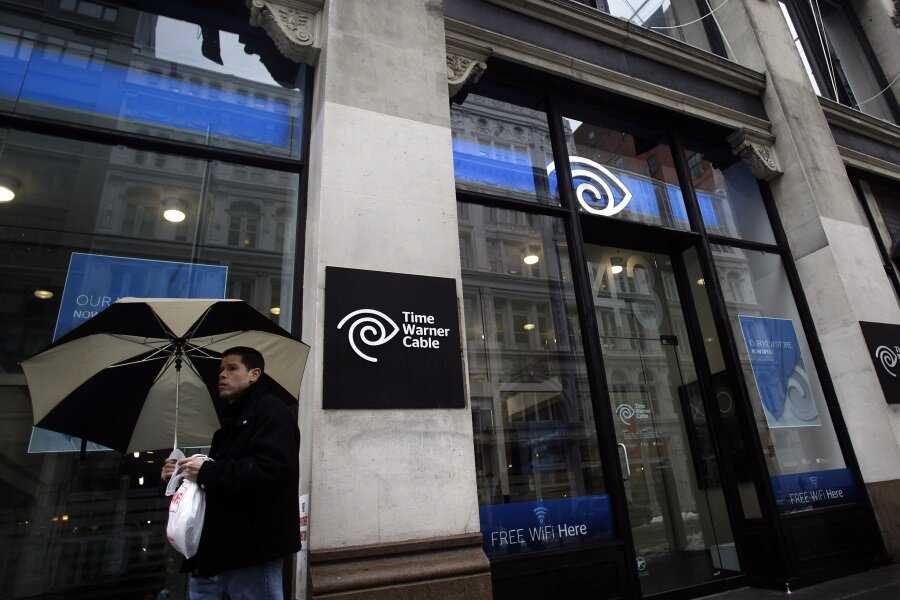With or without Comcast merger, industry is fast shifting beyond ‘cable’
Loading...
| Washington
A message emerged loud and clear this week: When it comes to the Internet and video wiring that millions of Americans plug into on a daily or hourly basis, regulators are on guard against letting any single company gain undue power.
Antitrust regulation is alive. Even for the cable guy, and even when free-market forces are already causing turbulent competitive upheaval.
Comcast acknowledged Friday that it was abandoning a proposed merger with Time Warner Cable. This came after the Federal Communications Commission (FCC) and Justice Department made clear they were souring on the idea of allowing a deal that would combine two of the biggest providers of cable TV and broadband Internet service.
That’s the regulatory climate, even though the communications industry is in an era of rapid change. In many ways, Americans are moving beyond cable in how they spend their digital time.
Consumers are increasingly watching video on “streaming” services piped over the Internet, prompting more people to drop traditional cable TV service altogether. And when video or data goes wirelessly to smartphones, companies like Comcast can be cut entirely out of the revenue stream.
Offering “should you ditch cable?” guidance has become a cottage industry for technology reporters.
Even if there weren’t such changes underfoot, the merger still would have drawn regulatory scrutiny, as two such major players sought to join.
And an argument can be made that, given the rising competition to traditional cable TV, antitrust regulators should have just let the deal go through and watch things evolve. Some industry experts note, for example, that it was only 10 years ago that antitrust worries were aroused by proposed merger of two rental video chains. Not so many people visit Blockbuster anymore.
Still, even with the rise of cable alternatives like Sling TV and Netflix, the proposed deal between Comcast and Time Warner looked to regulators like the resulting marketplace clout would cross an unacceptable line.
"The proposed transaction would have created a company with the most broadband and the video subscribers in the nation alongside the ownership of significant programming interests," FCC Chairman Tom Wheeler said in a statement released Friday.
"Today, an online video market is emerging that offers new business models and greater consumer choice,” Wheeler added. “The proposed merger would have posed an unacceptable risk to competition and innovation, including to the ability of online video providers to reach and serve consumers."
The fact is, even in a fast-changing industry, lots of people still watch traditional TV and rely on wired communications for phone and Internet service. Typically a household can choose from only a few providers (like Comcast or the FiOS service developed by phone company Verizon) for access to that “last mile” of wiring that brings signals to the home.
By some estimates, a combined Comcast and Time Warner would have represented 60 percent of the cable TV market and nearly that much of the residential broadband Internet business. On the content-creation side, Comcast owns NBC-Universal while Time Warner Cable has HBO.
To groups like Consumers Union, all this made the case against the merger compelling. (The group says more than a million Americans actively opposed the deal through petitions and comments to the FCC.)
Industry analysts, meanwhile, say Comcast and Time Warner aren’t left reeling by the deal’s collapse. Both stocks are near five-year highs.
Still, there’s no getting past the change that’s sweeping the communications industry. Comcast and Time Warner will have to keep adapting right along with everyone else.
Programming costs are rising, putting a squeeze on business models for any company delivering content to consumers.
Meanwhile, the dashing of their merger hopes coincided with the Obama administration’s push for “net neutrality,” the idea that firms like Comcast shouldn’t set up “fast lanes” on the Internet where some content providers might pay for favored access to consumers.
More broadly, traditional cable firms face a squeeze as customers migrate away from the cable model toward web-based TV viewing.
The trend suggests that these firms will increasingly center their business on the Internet service, rather than on traditional cable. And within their still-large cable arena, it puts pressure on firms like Comcast to offer something closer to a la carte offerings, rather than big bundles where you get dozens of channels whether you want them all or not.
Earlier this week, for example, Verizon announced a service called “Custom TV” for FiOS customers who want to start with a leaner set of basic channels and choose their add-ons.
Another telling sign of the times: Even as it still markets HBO as a premium channel for traditional cable customers, Time Warner has recently launched HBO NOW, a streaming service to reach the ditch-cable crowd.
Other options for consumers are proliferating.
Sling TV offers television channels over the Internet, with a $20-per-month package that includes some key sports (ESPN) , news, and general entertainment offerings.
As Hulu and Netflix offer on-demand TV shows and movies, plug-in hardware like a Roku or Google Chromecast stick can port web-based video to the TV screen.
And all this content needs to compete with the compelling “free” stuff called social media – like the newly ascendant Meerkat app for streaming of personal video feeds.
The video-business shakeup doesn’t mean consumer prices are headed relentlessly down. (The cost of “Game of Thrones” doesn’t change just because a consumer now can buy HBO in an a la carte format.)
But it does mean consumer choices are heading up. And regulators seem determined to encourage the process to run its course.








